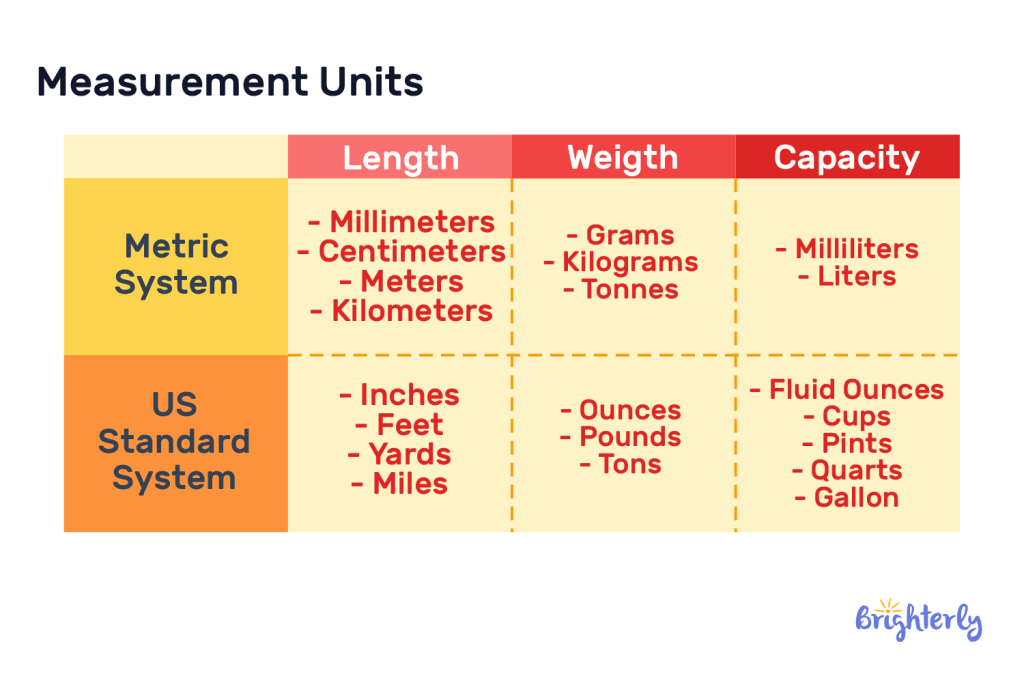Measurement: Definition, Examples, and Practice Problems
reviewed by Jo-ann Caballes
Updated on October 7, 2024
Understanding measurement is an important skill for every child. With Brighterly, children can learn the core concept of measurements, types of measurements, and relevant examples in a fun and engaging way!
What is Measurement?
Measurement is a process of attributing numeral qualities to material objects. The three types of measurement are:
- Length
- Mass
- Volume
Some other types include temperature, capacity, time, and so on.
How do measurements work
Measurement helps us determine the answers to questions such as:
- How tall are you?
- How far is your house from school?
- How heavy is your neighbor’s car?
With measurement, we can answer these questions as:
- I am 4’5 inches (in) tall
- My house is far from my school by a mile
- My neighbor’s car weighs 1.5 tons
Unit of measurement: meaning
Measurement units or units of measurement are the classifications used to determine the numeral values of objects. It tells us how long or heavy an item is, the distance to get to a place, the coolness of the weather, and so much more.
Types of measurement units
There are two types of units of measurement: the universally recognized metric system and the standard system used in the United States, also known as the Imperial System of Measurement.
The metric system uses meters, centimeters, grams, and so on.
However, the U.S. standard system uses inches, feet, miles, pounds, tons, yards, etc.
Units of measurement can be classified into these parts:
- Height
- Weight
- Quantity
The image below shows the measurement units in the metric system and their alternative in the US standard system:

Other concepts that can be measured are volume, time, money, and temperature.
Unit of measurement examples
The following are some units of measurement and their examples:
Length
The length of an item is how long an object is or how wide two distances are from each other.
Length can be measured in meters, centimeters, and feet when determining the height of an object or smaller distances. It can be measured in kilometers and miles for longer distances.
Here are some examples of measurement units under length according to the international metric system:
- Centimeter (cm): is a unit of measurement used for width, height, and distance. A grain of rice is about a centimeter in length, you can measure things like your toothbrush, the size of a notebook, etc in centimeters.
- Meter (m): measures height and width larger than the centimeter. The average adult is 1.7 meters (m) in height.
- Kilometer (km): is mainly used for estimating long distances. A bridge can be 1km in length and the distance between two cities can be measured in km (e.g. the distance from New York to Philadelphia is 150 km approx.).
1m = 10Ocm.
1km = 1,000 meters.
For the US (imperial) system of measurement, here are some examples of measurement units under length:
- Inches (in): are for measuring small lengths and widths. In perspective, a soda cap is 1 inch, and you can measure your TV screen in inches.
- Feet (ft): measure objects and short distances. If you love sandwiches, you already know the foot-long subway sandwich is 1ft. Feet (ft) can be used to estimate a person’s height. For example, Anna is five foot and three inches tall. 1ft = 12in.
- Yard(yd): is mainly used to measure land areas such as fields, and parking lots, Yard is also used for measuring cloth fabrics. 1yd = 3 ft
- Mile(mi): measures larger distances. We can use miles to estimate how far a place is. This is why cars often have mileage—to show how far they can travel. 1 mi = 1,760 yd.
Here iis the conversion of the US standard measurement system to the internationally recognized metric system and vice versa:
- 1 inch = 2.54 cm
- 1 foot = 30.48 cm
- 1 yard = 91.44 cm
- 1 mile = 1.609 km
Weight
Weight is the level of matter that makes up an object due to the gravity that pulls it down. This makes some objects light or heavy regardless of its size. We can measure weight in grams, metric tons, pounds, and ounces.
The following are examples of measurement units used to scale the weight of objects per the international metric system:
- Milligrams: This measurement unit is used for objects that possess a tiny weight, To illustrate, a grain of sand is 1 milligram and things like medicine, sugar, and spices are measured in milligrams (mg).
- Grams: are used to determine the weight of small objects too, but, they weigh more than a milligram. To put it in perspective, a piece of gum is 1 gram (g).
- Kilogram: is the most common unit of measuring mass internationally except in the US. Items like travel luggage, groceries, and even small pets like hamsters and cats can be measured in kilograms (kg).
1g = 1000mg
1kg = 1000g
People in the US use these examples of measurement units for weight:
- Ounces (oz): are used to measure tiny objects with very little weight. Beverages and foods are usually measured in ounces
- Pounds (ib): measures heavier objects than the ounces such as the weight of a human being or the weight of a large animal.
- Tons (t): is for measuring much larger and heavier objects like an airplane.
1 pound = 16 ounces
1 ton = 2000 pounds
Volume
With volume, we measure how much space an object contains; whether solid, liquid, or gas. Solids are measured in cubic units, liquids are measured in gallons, pints, quarts, liters, etc. Gas may be measured in the same volume as solids and liquids.
Here are some conversions for volume:
- 1 pint = 2 cups
- 1 quart = 2 pints
- 1 gallon = 4 quarts
- 1 liter = 1,000 milliliter

Capacity
Capacity measures the quantity that can be contained in an object.

Time
Time is the ever-continuous movement of events. It can be measured in seconds, minutes, hours, days, weeks, months, and years.
Time can be converted into some of the following:
- 60 seconds = 1 minute
- 60 minutes = 1 hour
- 24 hours = 1 day
- 7 days = 1 week
- 4 weeks (approximately) = 1 month
- 12 months = 1 year
Money
Money is the medium of exchange used to buy and sell goods and services. Money can be measured depending on where you are located. In the US, for example, here are some conversions of the US Dollar:
- 1 penny = 1 cent
- 1 nickel = 5 cents
- 1 dime = 10 cents
- 1 quarter = 25 cents
- 1 dollar = 100 cents
Temperature
Temperature is the measurement of the hotness or coldness of the atmosphere, a place, or an object. To measure temperature, we use an instrument called a thermometer.
Temperature is measured in Degree Celsius (°C) and Kelvin (K) per the international metric system. However, It is measured in Degrees Fahrenheit (°F) per the US customary system.
Fahrenheit can be converted to Celsius with the formula:
°C = (°F – 32) × 5/9
Celsius can also be converted to Fahrenheit:
°F = (9/5 × °C ) + 32
Other formulas for conversions between temperatures can be found in this image:

Things you can measure
Most things can be measured; from household items to the air you breathe.
Here are some examples of things you can measure:
- A table can be measured in weight, length, and the capacity it can support
- A swimming pool can be measured in length, depth, and volume of water it can hold
- You can measure a cup of coffee by its weight, volume, and even temperature if it’s hot or cold.
- You can measure a car by its weight and length, etc.
Have your ward look at their surroundings, what else can they measure, and how?
Solved Math Tasks – Measurement: Examples
Solved math problem 1
Heather is 5 feet (ft) and 2 inches (in) tall, how tall is she in centimeters (cm)?
Answer
1 inch = 2.54 cm
1 foot = 30.48 cm
2 in = 2.54 cm × 2
2 in = 5.08 cm
5 ft = 30.48 cm × 5
5 ft = 152.4 cm
5ft 2 in = 152.4cm + 5.08cm
| 5ft 2in = 157.48 cm |
Solved math problem 2
A bowling ball weighs 4.5 kilograms, how much does it weigh in milligrams?
Answer
1 kilogram = 1,000 grams
1 gram = 1,000 milligrams.
First, convert to grams:
4.5 kg = 1,000g × 4.5
4.5 kg = 4,500 g
Then, convert to milligrams
4,500 g = 1,000 mg × 4,500
4,500 g = 4,500,000 mg
| Therefore, 4.5 kg = 4,500,000 mg. |
Solved math problem 3
Tony buys 3 gallons of gas, how much is the gas when converted to pints?
Answer
2 pints = 1 quart
4 quarts = 1 gallon
Therefore, 8 pints = 1 gallon
3 gallons = 8 pints × 3
| 3 gallons = 24 pints. |
Measurement: Practice Math Problems
Measurement: worksheets
Learn more about the different ways to measure, other types of measurements, and how to apply them with Brighterly’s free worksheets:
- Measurement worksheets
- Measuring lengths worksheets
- Measurement conversion worksheets
- Metric system worksheets







